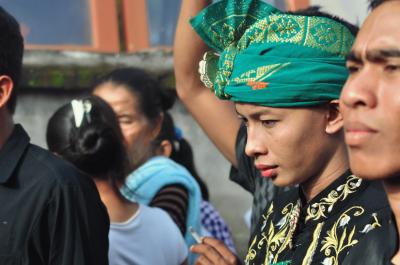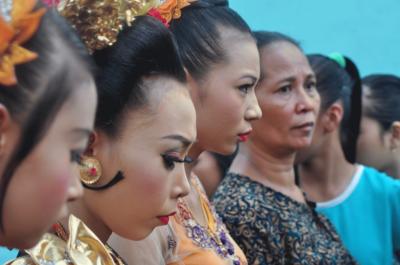- TOP
- 資料館
- FOCUS
- March 2019 - Volume 95
- Child Marriage in Indonesia: Resolving an Issue
FOCUS March 2019 Volume 95
Child Marriage in Indonesia: Resolving an Issue
Child marriage is a form of violence against women and girls, as it deprives them of their rights to education, healthcare, and freedom from violence, among others. Indonesia has committed to end child marriage in order to reach the Sustainable Development Goals (SDGs) by 2030.
However, as of 2016, it is estimated that one in nine girls in Indonesia will marry before the age of eighteen1 and, due to its large population, the country is among the ten countries worldwide with the highest absolute number of girls married while underaged.2
The Issues
The research on child marriage in Sumenep Regency, Madura, East Java undertaken by Rumah KitaB3 in 2015 shows that close to 70 percent of the people in the regency got married before the age of eighteen. The district of Dungkek in the regency had the highest number of child marriage, with about 80 percent of its nearly four thousand people - as per national population records in 2015 - having married as children.
The research also reveals that child marriage is caused by different factors and circumstances. But there is one common factor that led to it - either the complete absence of parental guidance due to migration, or weakened family structures resulting from divorce or pressures related to survival in the face of poverty.
Another research conducted in Lombok, West Nusa Tenggara province involving four girls (identified as Rita, Ida, Vera and Idawati)4 reveals the significant roles played by religious and community leaders in Lombok, West Nusa Tenggara. Young couples who eloped (merariq) are urged by these leaders to marry immediately, and insist that marriage is the only solution to the situation to prevent shame on the whole village. The community has a strong culture of shame. It recognizes the religious and community leaders as custodians of customary rules. These customs are reinforced by Islamic religious values that add greater pressure to eloping young couples to marry.
Unmarried girls who eloped and failed to immediately marry are subject to social pressure including gossip and ridicule. They would be referred to as mayung bakat (literally meaning “injured deer”), dedare toaq/mosot (old spinsters) or “tainted” and thus a disgrace to the family. Boys on the other hand are not subject to these social mores.
For girls who get pregnant, religious values require marriage in order to have the names of both parents listed on the child’s birth certificate. According to Islam, the relationship of a child to the father can exist once ijab qabul (exchange of marriage vows) has occurred. Outside of marriage, the child would only be officially related to the mother.
Girls who marry early are forced to bear the financial burden of their households through informal work, and not allowed to continue their education (but the boys continue their study). Many are forced to raise children alone (as in the cases of Rita and Ida). Child marriage is also associated with the high divorce rate in Lombok. Being psychologically ill-equipped at such young age to deal with marriage and economic pressures, many child marriages lead to divorce within one year.

Wedding reception in Lombok (Photos by Morenk Beladro)
Health and Child Marriage
Studies on child marriages often refer to the impact of underage marriage on women’s reproductive health. From the four case studies in Lombok, three of the girls experienced adverse effects on their reproductive health. One showed signs of anemia during her pregnancy, and another experienced bleeding due to an underdeveloped uterus. A third one was administered contraception at a very young age. 80 percent of teens in Lombok suffer from anemia, a condition affecting the uterus and nutrient supply to an unborn child. This poses risks during and after (postpartum) birth. Furthermore, the impacts of child marriage on reproductive health are not limited to physical health, but also to the psychological health of the girls who have not yet reached a level of maturity required to raise a child.
The 2013 data from Lombok, show the mortality rate of women as shown in the table below.
| Pre-natal | Natal | Post-Natal | Amount | |
| Mataram | 3 | 2 | 9 | [14] |
| East Lombok | 10 | 0 | 25 | 35 |
| Central Lombok | 1 | 3 | 16 | 20 |
| West Lombok | 4 | 3 | 3 | 10 |
| North Lombok | 0 | 0 | 2 | 2 |
| Total | [81] |
(Source:West Nusa Tenggara(NTB)Statistics Office5)
The Lombok statistics show that the highest rate of maternal mortality occur at the post-natal phase. The leading causes of maternal mortality in Lombok are bleeding, infection, complications associated with heavy workloads following birth, and poor health and sanitation facilities.
Infant mortality, on the other hand, usually occurs when infants are around one month old, and two-thirds of the cases occur when infants are around one week old. The West Lombok Health Department sees low birth weight, often related to the physical and mental condition of young, ill-prepared mothers, as the biggest factor for infant mortality. These factors also relate to the high rate of maternal mortality in Lombok, especially when a mother’s reproductive organ is not yet fully mature.
Measures to Address Child Marriage and Health Problems
The Indonesian Marriage Law of 1974 provides that a girl of at least sixteen years of age can marry with parental consent. But the Law on Child Protection of 2002 defines a person under the age of eighteen as a child regardless of gender. The conflict between the two laws was brought to court. On 13 December 2018, the Constitutional Court of Indonesia issued an order declaring the provision of the Indonesian Marriage Law of 1974 on marrying age for girls unconstitutional and discriminatory against girls. It also considered this legal provision as against the law on child protection.6
But the question remains, how can child marriage be stopped at the level of the community? The people know the law on marriage and in a number of cases prevented the application of the law by using the traditional marriage system to allow child marriage,7 or by using the legal process with falsified documents on their age.
Of the four case studies examined in the research, it is clear that there is a link between child marriage, social change and cultural stagnation in terms of the application of merariq in Lombok’s case or fear of becoming an “old spinster”8 in other cases.9 Due to the absence of parental guidance and support, low levels of maturity and education, the girls agreed to marry. They viewed marriage as a solution to the problems they faced at home. Social and institutional pressures and the strict application of cultural traditions by community and religious leaders make it difficult for girls like Rita and Vera to be allowed to continue their schooling and postpone marriage until they are physically, emotionally and psychologically more equipped to deal with the pressures of marriage and raising a family. The case of Vera (who continued her study after marriage) however is a clear example of how intervention by legal aid providers and provincial and district legal institutions can lead to much better outcomes for girls particularly in relation to education.
Therefore, besides working at the national level to raise the minimum age of marriage for girls, working together with formal and non-formal institutions at the community level is crucial since these institutions are the “gatekeepers” who have power to allow and, at the same time, to prevent child marriage at the community level.
Lies Marcoes is the Executive Director while Fadilla D. Putri is the Program Manager of Yayasan Rumah Kita Bersama.
For further information, please contact: Lies Marcoes and Fadilla D. Putri, Yayasan Rumah Kita Bersama (Rumah KitaB), Rawa Bambu I, Blok B/7, Pasar Minggu, Jakarta 12520 Indonesia; ph (6221) 7803440, 778837997; e-mail: official[a]rumahkitab.com; www.rumahkitab.com.
*This article is largely based on the 2015 report of the authors entitled Child Marriage and the Phenomenon of Social Orphans in Lombok, Rumah Kita Bersama and Australia Indonesia Partnership for Justice, and the 2016 report entitled Testimony of the Child Brides - Summary of Results of Research Study on Cases of Child Marriage and the Role of Institutions in Nine Regions in Indonesia, April 2016. More recent documents supplemented the discussion from these reports.
Endnotes
1 UNICEF Indonesia Factsheet: Child Marriage in Indonesia, 2017.
2 UNICEF, State of the World's Children, 2017.
3 Lies Marcoes and Fadilla Dwianti Putri, Testimony of the Child Brides - Summary of Results of Research Study on Cases of Child Marriage and the Role of Institutions in Nine Regions in Indonesia, April 2016.
4 The four women in the case studies were identified through consultation with local activists, government officials and community members. The interviews were held after getting the approval of the woman, her parents and village leadership.
5 Lies Marcoes and Fadilla Dwianti Putri, Child Marriage and the Phenomenon of Social Orphans in Lombok, Rumah Kita Bersama and Australia Indonesia Partnership for Justice, 2015, page 4.
6 See Agustinus Beo Da Costa, “Court ruling brings Indonesia closer to ending child marriage: campaigners,” Reuters, www.reuters.com/article/us-indonesia-women-marriage/court-ruling-brings-indonesia-closer-to-ending-child-marriage-campaigners-idUSKBN1OC1CM
7 See discussion on role of institutions in Testimony of the Child Brides - Summary of Results of Research Study on Cases of Child Marriage and the Role of Institutions in Nine Regions in Indonesia, op. cit.
8 Translated from the Indonesian language “perawan tua.”
9 Marcoes and Putri, Testimony of the Child Brides - Summary of Results of Research Study on Cases of Child Marriage and the Role of Institutions in Nine Regions in Indonesia, op. cit.

